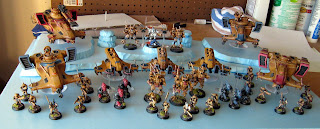During The Necronomicon last weekend, the Hardliners were pleasantly surprised when our own Tog was awarded “40K Player’s Choice” awards in the unit and army category with his wonderfully highlighted Tau. When it came to painting, his army was easily in the top 5 (out of 70) armies present. However, it would be hard to say that it was number one. This phenomenon is not an isolated case; as I’ve been to several tournaments where the best painted models (as determined by color selection, technical proficiency, and technique difficulty) did not win the award. There always appears to be an aspect of the winning model, beyond skillful paint application, that makes it rise to the top. The below discussion is my exposition on the “Player’s Choice Award” based on observations of miniature appearance competitions for the last 10 years.
First of all, the evaluation of painted miniatures is subjective. In the absence of specific grading criteria (which is often the case), judges will grade a model in a similar manner as a fine work of art; which is based on numerous categories of personally-appreciated aesthetics. Although I think it is impossible to define criteria by which one can predict the allure of one fine work of art over another, I do think it is [much more] possible to create a set of rules that can closely approximate the appeal of one army/figure over another due to the shared subject matter, media, and audience demographic in miniature wargame modeling.
If painting skill only distills the list of competitors to the top 5%, what aspects of the model or army make it more compelling?
1. The army/figure must grab your attention from a distance. Sometimes this is difficult because, by their nature, miniatures are small. I have noticed these four techniques used effectively:
a) Use large models (such as vehicles, monstrous creatures, giant banners)
b) Stage your model(s) on a large and/or decorative base (e.g. plinth for single models, elaborate movement trays for units, or dioramas for armies)
c) Use bright colors
d) Paint the model(s) with a high degree of contrast
2. The army/figure should look unique. Of course, the technique that is used to achieve uniqueness must still be appealing and appropriate. I have noticed several ways to achieve this aspect:
a) Use a rare model (e.g. special edition release, out of print, one-of-a-kind sculpts, etc)
b) Significantly modify a common model (e.g. combine parts from several models, sculpt changes, etc)
c) Combine models from different genres (e.g. use raptors to represent jet bikes, etc)
d) Paint the models in a manner that is rarely seen (e.g. Non-metallic metal, complex blending, monochromatic, etc)
There ya go! Two rules that sound simple yet can be followed in an infinite number of ways. Obviously, I’m suggesting that the viewers need to be “wow’d” by the models as well as impressed by the painting. Furthermore, I propose that it is the modeler that is most talented in his application of these two rules (which involves more than just painting) that most often wins the “Player’s Choice” award.
One parting question for the readers (assuming you mostly agree with my ideas): Do you think that an army/model’s chances of winning Player’s Choice go down if the audience has already seen the model(s) before (i.e. from a webpage, previous competition, etc) since some of the “wow factor” was been reduced?

































 >
>












